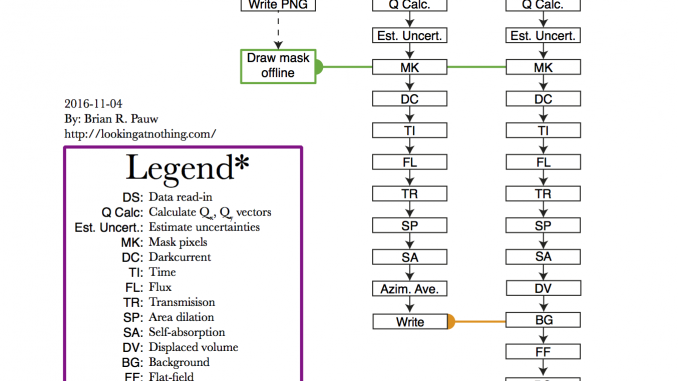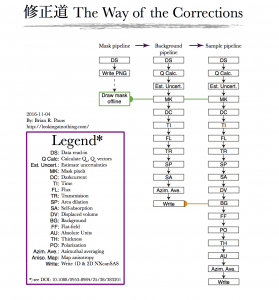
Over the last few years, I’ve developed, discussed, adapted and tested a pipeline for the most convenient order of SAXS image data corrections. This is particularly geared towards pinhole-collimated X-ray scattering using Pilatus-like detectors (it doesn’t contain many of the funky detector corrections (yet) to keep it simple). I’m bringing this up as an RFC (also here), hoping to turn it into a recommended sequence that can serve as a decent starting point for getting your data right…

You may recognize the schema (Figure 1) from before, it has undergone several iterations already, some of which landed on this website. The corrections are ordered to reduce pixel-by-pixel (elementwise) image operations, which is why the flatfield correction is only applied after background subtraction. Naturally, many corrections can be grouped together, but are here shown separated for clarity and error checking. The “DV” correction is the one discussed here, but can only be applied when the user knows enough about their scatterers.
For clarification: the “background” measurement is everything except the actual nanostructure: i.e. the capillary with solvent for suspensions. In alignment with recent suggestions in the ISO standardization process, measurements on liquids are to be done using either a flow-through cell or a reusable capillary to minimize the cell differences in measurements. While it can (with great care) be done using different capillaries, many potential pitfalls in data correction can be avoided with the use of the aforementioned containers.
Desmearing corrections are not in there, as it is better dealt with from the modeling side (where the model can be smeared). Likewise, the Lorentz correction is not in there as it relates only to peak intensity correction in diffracting systems.
I’d like to throw this in the group, to ask if we can turn it into a suggested or recommended order of corrections for SAXS data (i.e. it may not be suited for USAXS or SANS). Agreement on the data correction scheme will likely further improve the consistency between datasets recorded on various instrumentation.
Please let us know in the comments below if there is anything you are missing, or if you think a particular correction should be elsewhere.

Leave a Reply